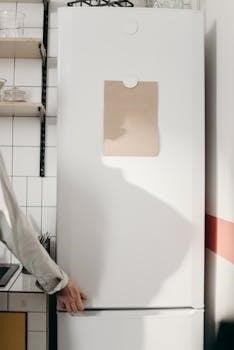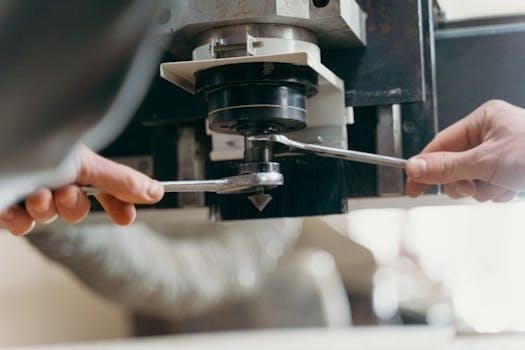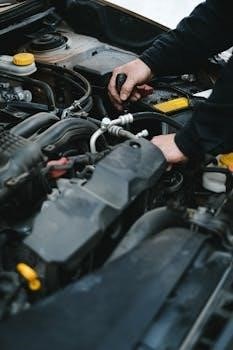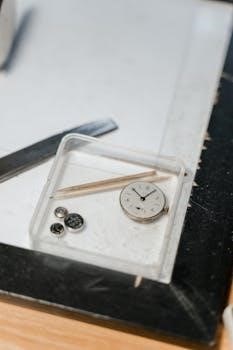whirlpool refrigerator parts list manual
Understanding your Whirlpool refrigerator’s components is crucial for maintenance and repair. Parts manuals, diagrams, and exploded views are essential for identifying and locating each part. These resources help ensure proper fit and function when replacing components.
Understanding the Importance of Parts Manuals
Parts manuals are invaluable for anyone needing to repair or maintain their Whirlpool refrigerator. These manuals provide detailed diagrams, exploded views, and parts lists, enabling users to accurately identify specific components. Using a manual ensures you order the correct part, prevents installation errors, and simplifies the repair process. They also offer crucial information on part compatibility, which is vital for proper function and safety. Utilizing your refrigerator’s parts manual ultimately saves time and money by streamlining the repair process.
Locating Your Whirlpool Refrigerator Model Number
Finding your Whirlpool refrigerator’s model number is essential for ordering correct parts. This number is typically located inside the refrigerator compartment or on the exterior of the unit.
Why Model Numbers are Crucial for Parts Identification
Whirlpool refrigerators come in various models, each with unique parts. The model number ensures that you order the exact components designed for your specific unit. Using the wrong parts can lead to improper fit, reduced performance, or even damage to the appliance. Therefore, accurate model identification is essential for successful repairs and maintenance, guaranteeing the correct functionality and longevity of your refrigerator and avoiding unnecessary issues, as well as wasted costs. Always verify the model before purchasing.

Common Whirlpool Refrigerator Parts Categories
Whirlpool refrigerator parts are categorized by function, such as cabinet, liner, door, shelf, and unit parts; Understanding these categories simplifies the process of locating specific components for repair or replacement.
Cabinet Parts⁚ Structure and Support
Cabinet parts form the structural framework of your Whirlpool refrigerator. These components provide support and house all other internal parts. Key elements include the exterior panels, the base, and any supporting frames. These parts are crucial for maintaining the refrigerator’s integrity and ensuring its stability. Proper maintenance of these components helps prevent damage and extends the lifespan of your appliance. Diagrams can aid in identifying these specific structural elements.
Liner Parts⁚ Interior Components
Liner parts are the interior components of your Whirlpool refrigerator that create the food storage space. This includes the inner walls, the back panel, and the floor of the refrigerator compartment. These components are designed to provide a smooth, easy-to-clean surface, and they contribute to the insulation of the unit. Understanding the liner parts aids in identifying damage and ensuring proper maintenance. Diagrams in parts manuals help locate each specific liner component accurately.
Door Parts⁚ Refrigerator and Freezer
The doors of your Whirlpool refrigerator and freezer consist of several parts, including the door panels, gaskets, handles, and shelving. These components ensure proper sealing, insulation, and accessibility. The refrigerator door parts and freezer door parts are often different, with specific designs for each compartment. Diagrams and parts lists help in identifying the unique components and their correct placement. Understanding these parts is crucial for maintaining the refrigerator’s efficiency and preventing temperature loss.
Shelf Parts⁚ Storage and Organization
Whirlpool refrigerator shelves are essential for organizing and maximizing storage space. These parts include various types of shelves such as wire, glass, and spill-proof shelves. Different models may have adjustable or specialized shelves like door shelves, crisper drawers, and deli drawers. Diagrams and parts lists are invaluable for locating the correct replacement shelves. Properly functioning shelves ensure your food is stored safely and efficiently. Understanding these components helps maintain an organized and functional refrigerator interior.
Unit Parts⁚ Core Functionality
The core functionality of a Whirlpool refrigerator relies on its vital unit parts. These include components such as the compressor, condenser, evaporator, and defrost system. The compressor circulates refrigerant, while the condenser releases heat. The evaporator absorbs heat to cool the refrigerator. The defrost system prevents ice buildup. These parts are critical for the refrigerator’s cooling process. Identifying these parts using diagrams is essential for accurate repairs. Maintaining these components ensures optimal performance and longevity of your appliance. Proper care of unit parts will help avoid potential issues.

Specialized Components of Whirlpool Refrigerators
Whirlpool refrigerators include specialized components like dispensers, ice makers, and air flow systems. These parts enhance functionality and convenience. Understanding these specific systems is essential for maintenance.
Dispenser Parts⁚ Water and Ice Systems
The water and ice dispenser system in Whirlpool refrigerators involves several components. These include the water filter, which purifies incoming water, and the water valve, controlling the flow. The dispenser assembly itself houses the levers and buttons. Understanding this system is vital for troubleshooting issues like leaks or dispensing problems. Additionally, the ice chute and related mechanisms ensure the proper delivery of ice. Regular maintenance of these parts ensures optimal performance.
Ice Maker Parts⁚ Ice Production
The ice maker system in Whirlpool refrigerators is a complex mechanism with several key components. These include the ice maker module itself, which controls the ice-making cycle, and the ice mold, where the ice cubes are formed. The water inlet valve supplies water to the ice maker, and the ejector arm pushes the ice into the storage bin. Proper functioning of these parts is necessary for consistent ice production. Understanding this system assists with troubleshooting and maintenance.
Air Flow Parts⁚ Cooling System
The air flow system within a Whirlpool refrigerator is vital for maintaining consistent temperatures. Key components include the evaporator fan motor, which circulates cold air throughout the compartments. The damper controls the flow of air between the freezer and refrigerator sections. Air ducts and vents ensure that cool air reaches all areas, preventing hot spots. Proper functioning of these parts guarantees efficient cooling. Understanding this system helps to identify and fix temperature fluctuations and other cooling-related issues.

Using Diagrams for Parts Identification
Diagrams are essential for locating specific refrigerator parts. Exploded views show how components fit together, aiding in proper identification and repair. They provide a visual guide for ordering correct replacements.
How to Interpret Exploded View Diagrams
Exploded view diagrams are visual representations showing how a refrigerator’s parts fit together. Each component is depicted separately but in its correct position relative to others. Numbers or letters on the diagram correspond to a parts list, enabling precise identification. These diagrams are invaluable for understanding the assembly and disassembly process. By carefully examining the diagram, users can easily locate the required part, enhancing repair accuracy and efficiency. It makes the process of finding and identifying the correct part much easier.
Finding the Correct Part on a Diagram
To locate the right part on a diagram, first identify the general area of the refrigerator where the part is located. Then, consult the corresponding exploded view diagram. Each part is usually labeled with a number or letter, which corresponds to a detailed parts list. Cross-reference the diagram label with the list to find the part’s name and part number. This detailed process ensures that you select the precise component, simplifying both ordering and replacement procedures. Careful attention to detail is crucial for a successful outcome.

Troubleshooting and Repair Resources
Access online help, videos, manuals, and error code tables for troubleshooting Whirlpool refrigerators. These resources offer guidance for diagnosing issues and performing repairs with confidence.
Accessing Online Repair Help and Videos
Numerous online resources provide repair assistance for Whirlpool refrigerators. Websites offer troubleshooting guides, step-by-step video instructions, and expanded diagrams. These visual aids can assist in identifying parts and understanding repair processes. Many sites also provide expert advice and forums for specific issues. These tools can empower users to perform DIY repairs and save time and money. Look for manufacturer-approved support for accurate and reliable information. Accessing these online resources is a great way to address common problems.
Utilizing Manuals and Error Code Tables
Whirlpool refrigerator manuals are crucial resources for troubleshooting and repairs. These manuals often include exploded views, parts lists, and wiring diagrams. Error code tables, available in manuals or online, help pinpoint issues. Understanding error codes can lead to faster diagnoses and repairs. Manuals may also contain specific instructions for component replacement. Always refer to your refrigerator’s model-specific manual for accurate information. Utilizing these resources can streamline the repair process and ensure proper function of the refrigerator.
Purchasing Whirlpool Refrigerator Parts
When buying parts, choosing genuine OEM components is essential for proper fit and function. Trusted suppliers offer a wide range of parts with diagrams and manuals, aiding in the correct selection.
Identifying Genuine OEM Parts
When purchasing replacement parts for your Whirlpool refrigerator, it is vital to ensure you are selecting genuine Original Equipment Manufacturer (OEM) parts. These parts are specifically designed and manufactured by Whirlpool for your appliance, guaranteeing a perfect fit and optimal performance. OEM parts undergo rigorous testing to meet Whirlpool’s quality standards, ensuring reliability and longevity. Using non-OEM parts may lead to compatibility issues and could potentially damage your refrigerator, making it essential to choose authentic OEM components for repairs and maintenance.
Trusted Parts Suppliers
Finding reliable suppliers for your Whirlpool refrigerator parts is essential to ensure you receive genuine, high-quality components. Look for authorized dealers or reputable online retailers who specialize in appliance parts and have a proven track record of customer satisfaction. Consider suppliers that offer detailed parts diagrams, installation guides, and support to assist you in selecting the correct items. Moreover, selecting a supplier with a strong return policy and warranty options can provide added peace of mind when purchasing refrigerator parts.
Maintenance and Troubleshooting Tips
Regular maintenance is key to extending your refrigerator’s life. Simple DIY repairs can often resolve common issues. When in doubt, consult a professional for complex problems to ensure safe and effective repair.
Basic DIY Repairs
Many minor refrigerator issues can be addressed with basic do-it-yourself repairs. Tasks like replacing water filters, gaskets, and shelves are often straightforward. Consult your parts manual and online videos for guidance. Always disconnect power before starting any repair. Using genuine OEM parts will guarantee proper fit and function. Simple fixes can save time and money, extending the life of your appliance and its efficiency. Be sure to use the correct tools and follow safety guidelines to avoid any problems.
When to Call a Professional
While many repairs are DIY-friendly, some issues require professional expertise. Complex problems involving the compressor, refrigerant leaks, or electrical components should be handled by a qualified technician. If you’re unsure about a repair or lack experience, calling a professional is best. Attempting advanced repairs without proper knowledge can lead to further damage or safety risks. Professional service ensures the job is done correctly and safely, safeguarding your appliance and your home from potential damage.